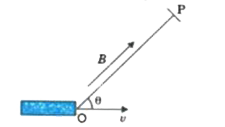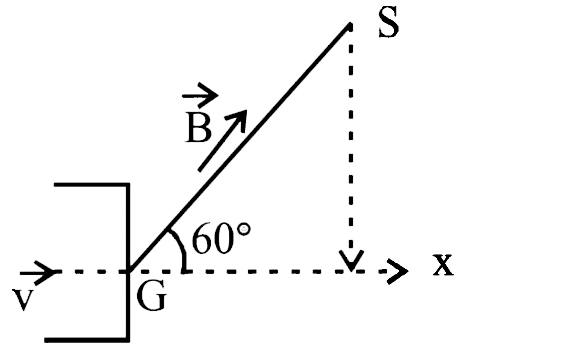One electron gun is firing electrons with a speed V as shown in the figure. There is a target P which is to be hit. Electrons emerge from point 0 and line OP makes an angle with the direction of velocity of electrons. The length of OP is L.A uniform magnetic field B is applied parallel to line OP. Charge on the electron ise and the mass of electrons is m. What minimum magnetic field is needed so that electrons may hit the target P?

Here, we can understand that electrons will follow a helical path with an axis parallel to line OP, so in every rotation the electron will touch some point on OP. Hence to strike the given target, length L must be an integral multiple of the pitch of the helix followed by electrons.
Pitch of the helix = Time period Component of
velocity parallel to field
Condition to strike the target
Pitch
For minimum possible magnetic field we can use .
Topper's Solved these Questions
- MOVING CHARGES AND MAGNETISMBook:MODERN PUBLICATIONChapter:MOVING CHARGES AND MAGNETISMExercise:Revision Exercises (Very Short Answer Questions )
Explore 59 Videos
- MOVING CHARGES AND MAGNETISMBook:MODERN PUBLICATIONChapter:MOVING CHARGES AND MAGNETISMExercise:Revision Exercises (Additional Questions )
Explore 16 Videos
- MOVING CHARGES AND MAGNETISMBook:MODERN PUBLICATIONChapter:MOVING CHARGES AND MAGNETISMExercise:NCERT (Exemplar Problems ) (Short Answer Type Questions )
Explore 6 Videos
- MAGNETISM AND MATTERBook:MODERN PUBLICATIONChapter:MAGNETISM AND MATTERExercise:CHAPTER PRACTICE TEST FOR BOARD EXAMINATION
Explore 16 Videos
- NUCLEIBook:MODERN PUBLICATIONChapter:NUCLEIExercise:CHAPTER PRACTICE TEST FOR BOARD EXAMINATION
Explore 15 Videos
Similar Questions

The motion of an electron in presence of a magnetic field is depicted in the figure. Force acting on the electron will be directed
View SolutionAn electron gun G emits electrons of energy 2keV travelling in the positive x−direction . The electrons are required to hit the spot S where GS=0.1m, and the line GS makes an angle of 60∘ with the x−aξs as shown in the fig. A uniform magnetic field →B parallel to GS exists in the region outside the electron gun. Find the GS exists in the region outside the electron gun. Find the minimum value of B needle to make the electron hit S.

View Solution
Knowledge Check
a strong magnetic field is applied on a stationary electron, then the electron
Amoves in the direction of the fieldBremains stationaryCmoves perpendicular to the direction of the fieldDmoves opposite to the direction of the fieldA strong magnetic field is applied on a stationary electron, Then the electron
Amoves in the direction of the fieldBremains stationaryCmoves perpendicular to the direction of the fieldDmoves opposite to the direction of the fieldWhen high speed electrons hit a target
Aonly heat is producedBonly continuous X -rays are emittedConly continuousand characteristic X-ray are emittedDheat is produced and simutaneously continuous and characteristic X-rays are emitted
An electron is travelling in east direction and a magnetic field is applied in upward direction then electron will deflect in
View SolutionAn electron beam enters a magnetic field right angles to it as shown in the Figure.

The direction of force acting on the electron beam will be :
View SolutionAn electron entres a magnetic field whose direction is perpendicualr to the velocity of the electron. Then
View SolutionAn electron is released from rest in a region of uniform electric and magnetic fields acting parallel to each other. The electron will
View SolutionThe angular momentum of electron is J. if e=charge of electron , m= mass of electron , then its magnetic moment will be
View Solution
